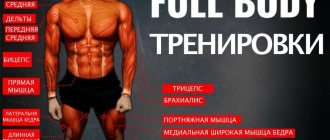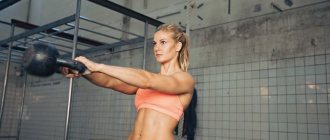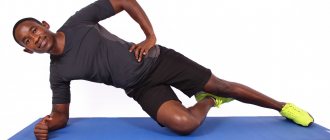From this day on, Zozhnik strengthens the direction of strength training with regular translations from the cult American website T-Nation, where the word “testosterone” is hidden behind the letter “T”. Today translation of the text “8 most effective training splits”.
To begin with, we will provide a link to the text “Full body or split” - for those who want to once again make sure, based on scientific research and expert opinions, that split is for them.
There are so many split options (distribution of exercises across days of the training week) that it can be overwhelming. But the program must be chosen for a specific purpose - and taking into account your level of training and individual characteristics. Let's look at 8 different schemes that effectively solve specific problems; choose what suits you.
Split by body part
This is the most common option in bodybuilding - frequent training (up to 5-6 times a week), each of which works specific muscles.
Pros: You load a muscle group rarely, but with concentration and intensity, performing more different exercises. This “shock” causes the muscles to grow, especially if you have previously trained in a full-body program. This is the best way to gain mass, but due to the increased volume and metabolic stress, it is suitable for experienced bodybuilders who are prepared for heavy loads.
Cons: You have to give up multi-joint exercises, since some muscles work in different movements and do not have time to rest between workouts.
You need to carefully monitor your diet and daily (sleep) routine in order to fully recover and tolerate training loads.
Split by body part takes a lot of time and is not suitable for people with a flexible work schedule - each workout loads its muscles, you cannot skip it. The goal of such a program is hypertrophy, it does not improve the performance of athletes and is not suitable for beginners.
Split example
Monday: Chest Tuesday: Back Wednesday: Shoulders Thursday: Legs Friday: Arms and Abs Saturday and Sunday: Rest
Top-bottom split
This scheme is a step from full body training to sectional splits. You increase the volume of exercise for the upper and lower half, but at the same time recover better. Over the course of one week, you can do 4 alternating workouts.
Pros: Top-bottom splits help you progress when full-body workouts have run their course. You continue to develop strength and gain mass. You can train more often, but use decent weights.
Cons: Many people get too carried away with their top workouts and become complacent with their bottom workouts. Since the same groups are worked more often, muscle recovery is worse than in a body part split. Heavy leg training twice a week can be taxing on the body and isn't for everyone.
Split example
Monday: Top (pressing exercises) Tuesday: Bottom (squats and variations) Wednesday: Complete rest or active recovery Thursday: Top (pulling exercises) Friday: Bottoms (deadlifts and variations) Saturday and Sunday: Rest
Advantages and disadvantages
Benefits of classes:
- Maximum quality pumping of certain muscle groups - a fullbody will never allow you to achieve similar results in the same period of time.
- Effective muscle recovery during the allotted rest time.
- Lifting heavy weights is ideal for gaining muscle mass.
- The inability to overtrain is natural, subject to compliance with safety standards and regulations.
The disadvantages include the fact that split training is not suitable for everyone. In addition, this is not the best option for endurance training.
Full body workout
To be fair, “full body training” is not exactly a “split”, but for the harsh and brutal T-Nation authors, it seems that full body training is just one of the varieties of split - approx. Zozhnik.
Working out the whole body in each workout is more effective if you have little time, and also healthier, because our body is still one whole, and not a collection of parts.
Pros: High-frequency full-body workouts help you lose weight and build strength by increasing the muscle size that grows with frequent stimulation.
This program is better for athletes who have other training besides iron. It teaches the body to optimally perform a small set of movements, rather than wasting effort on a dozen variations of movements.
Beginners should start with these workouts; they burn a lot of calories, lay a strength foundation, and improve health.
Cons: According to the authors of the text, hypertrophy of muscles that require a large training volume is not effective enough. Experienced strength athletes don't recover if they squat heavily three times a week.
Some muscles may be delayed in development, which is not suitable for bodybuilders.
This is a good option for rare workouts - up to 3 times a week. To go to the gym more than three or four times a week, you need to know your body well and control the intensity.
Split example
Monday: A. Rack clean 5x3 B. Bench press 3x6 C. Lunges 3x8-12 D1. Farmer's walk 3x30 seconds D2. Dips 3x 30 seconds
Tuesday: Rest
Wednesday: A. Push press 5×3 B. Deadlift 4×6 C. Pull-ups 3×8-12 D1. Plank 3x30 seconds D2. Dumbbell curls 3x 30 seconds
Thursday: Rest
Friday: A. Back squat 5×3 B. Bent-over row 4×6 C. Dumbbell bench press 3×8-12 D1. Farmer's Walk with one kettlebell overhead (one kettlebell in the lower arm as usual) [KettlebellCrosswalk] 3x30 seconds D2. Glute bridge on a 3×12 bench
Saturday and Sunday: Rest or general physical training.
Upper/lower split for beginners
Day 1 - Bottom
Day 2 - Top
Day 1 - Bottom
Day 1 - Bottom
Day 2 - Top
Quick squats with a barbell
- 4 sets of 6 reps
- Body part: Quadriceps Equipment: Barbell
Forward bends with a barbell on the shoulders “Good morning”
- 3 sets of 8 reps
- Body part: Hamstrings Equipment: Barbell
Jumping lunges
- 3 sets of 10 reps
- Body Part: Hamstring Equipment: No
Push ups
- 3 sets of 10 reps
- Body Part: Chest Equipment: No
Incline Dumbbell Press
- 3 sets of 8 reps
- Body part: Chest Equipment: Dumbbells
Reverse grip pull-ups
- 3 sets of 10 reps
- Body Part: Lat Equipment: Bodyweight
For trained athletes to gain mass, the following 4-day split is proposed. This program is only a basis for building split training. Each athlete must adapt the program to the characteristics of his body, time resources and experience.
Press/pull split
Here you divide exercises by type of movement: pressing and pulling. Most of the muscles in the back of the body work in rows, and in the front - in presses.
Pros: The push/pull split is good for those who want to train hard but are limited in time. You can practice the movement more often than in a body part split, which only hits muscle groups once a week.
Cons: Due to the distribution of the load across muscle groups working together, it is not suitable for athletes and beginners who still find it more effective to work the entire body at once. To benefit from this split, you need to have some training experience.
Split example
Day 1: Rows (upper back, spinal flexors, hamstrings, biceps) Day 2: Presses (chest, shoulders, triceps, quads, abs)
Home workout program for men: two-day split
List of exercises for effective development of the muscles of the upper half of the body:
- Warm up the muscles and ligaments.
- Do push-ups from the plane of the floor, arms wide apart.
- Place your feet on a chair and do push-ups.
- Using your hands, pull the body towards the horizontal bar, grabbing the crossbar with your hands with a wide grip.
- Perform a traction movement of the weight to the belt with your hand, in an inclined position, resting the surface of your hand and knee on the bench.
- Lift weights by moving your arms up while sitting on a chair.
- Perform alternate bending of the elbows with weights while sitting.
- Do the French press exercise, use dumbbells for weights.
- Twist the upper part of the body.
- Cool down and stretch the main muscle groups.
List of exercises for high-quality development of the muscles of the lower half of the human body:
- Do warm-up movements.
- Perform classic squats with dumbbells in your hands.
- Do Plie squats with weights.
- Make lunges with your foot forward, holding dumbbells in your hands.
- Apply the “Boat” exercise.
- Lift your body up, standing on your toes.
- Twist the lower part of the body while keeping the upper part pressed to the floor surface.
- Stretch the worked muscles.
Intensive/extensive split
In this scheme, the load on the nervous system varies, i.e. high intensity and volume. After a day of hard/speed training comes a day of longer, but less intense training. You can exercise 3 or 4 times a week.
Pros: An advanced option for athletes who have already exhausted regular full-body workouts. In addition to the physical fitness and strength supported by traditional loading, you work more on speed and power, improving performance in your sport.
Cons: This split is only for experienced ones; it requires a strict dosage of loads. Workouts on an intense day last longer because you need to rest a lot between sets of power exercises. This scheme stimulates hypertrophy less.
Split example
Monday: Acceleration exercises, weightlifting and other pushing exercises Tuesday: Metabolic training, pulling exercises Wednesday: Rest Thursday: Acceleration exercises, weightlifting and other pushing exercises Friday: Metabolic training systems (GPP), traction exercises Saturday and Sunday: Active recovery
What should an advanced athlete choose?
Once your body has adapted to strength training and gained a few pounds of muscle, it's time to increase your training volume. You can switch to split training or stay with a full body. The choice depends on your capabilities and goals.
When to try split sessions
If you need short workouts
If you can’t spend more than an hour in the gym—for example, you come home late from work or prefer to train at lunch—it’s better to choose splits. To properly tire 1-2 muscle groups, 40 minutes is enough. A full body workout will take much longer, since you will need to do at least 7-8 exercises.
Moreover, after the split you will feel much less tired than after a long full-body session. If training is not the last thing you will do, and after the gym you still have a whole day of work waiting for you, split sessions are best suited.
If you need to work out each muscle in detail
In split training, you can perform many isolated exercises to target different heads of the same muscle. This will allow you to harmoniously pump up all areas of the body and achieve a stunning look. But this only makes sense for experienced athletes with a significant amount of muscle mass.
If you can't handle large volumes
During strength training, not only the muscles become tired, but also the central nervous system (CNS). Mechanisms of Fatigue and Recovery in Upper versus Lower Limbs in Men hit it especially hard. multi-joint movements for the development of large muscle groups. Since they are the priority in full-body training, a large weekly volume can overload the Central and Peripheral Fatigue During Resistance Exercise - A Critical Review of the central nervous system, which will negatively affect the working weights and will not allow sufficient muscle fatigue.
Moreover, you may not notice A comparison of central aspects of fatigue in submaximal and maximal voluntary contractions: you will try your best, but a tired nervous system will stop turning on as many fibers as needed for fatigue and muscle growth.
In split sessions, you don’t have to perform many heavy exercises in one workout: you can finish off the target muscles with single-joint movements that are not so tiring for the central nervous system. This will increase the volume without the risk of overloading the nervous system.
When to try full body workouts
If you need to get rid of excess fat
With the same volume of training for the whole body, The effects of two equal‑volume training protocols upon strength, body composition and salivary hormones in male rugby union players burn twice as much fat as a split. Firstly, fullbody involves more multi-joint exercises and expends more energy. Moreover, both during the lesson and after it, during the recovery process.
Secondly, The effects of two equal‑volume training protocols upon strength, body composition and salivary hormones in male rugby union players provide a more favorable ratio of testosterone to cortisol than split. Since testosterone promotes fat loss, and cortisol, on the contrary, helps store it, fullbody provides a more favorable hormonal environment for weight loss.
If you exercise 2-3 times a week
If you can get to the gym no more than three times a week, for example due to work schedule or other commitments, full-body workouts will help to properly load your muscles and ensure their growth. Yes, you will have to spend more time in the gym, but you will not lose anything in terms of hypertrophy: each muscle will receive a good load and growth will not stop.
Take note ✅
- How to gain muscle mass
Split “agonists/antagonists”
In one workout, you work muscle groups that perform opposing movements, such as dumbbell bench press and dumbbell chest row.
Pros: These supersets lead to balanced development of strength in presses and rows. Alternating approaches for agonists and antagonists helps to increase working weights; increased blood flow to working parts of the body causes additional hypertrophy. The workouts are shorter and can be done more often – up to 6 times a week.
Cons: Not suitable for athletes who need to concentrate on specific movements. For beginners and older people, such loads are too great and require more recovery time.
Split example
Monday: Chest/Back Tuesday: Legs/Shoulders Wednesday: Rest Thursday: Chest/Back Friday: Biceps/Triceps Saturday and Sunday: Active recovery or complete rest
Program options
Split training can be developed independently, taking into account the individual characteristics of the athlete, the main thing is not to forget about the basic rules of the complex. Do not do more than eight exercises for selected muscle groups in one visit to the gym and do not exercise for more than two hours: this reduces efficiency.
There are different types of split training. Let's look at the main ones.
Program for obtaining relief
This type of training is designed for athletes who already have muscle mass - everyone else needs to gain it first.
Day 1: chest and back, 3-4 sets of 12-15 reps:
- Incline dumbbell press.
- Wide grip pull-ups.
- Bent-over barbell press and bent-over row.
- Abdominal exercises: 4-5 sets of 25-30 repetitions.
- Raising dumbbells to the sides while bending over and lying down.
Day two - deltoids, triceps and biceps, 3-4 sets of 12-15 reps:
- Dumbbell lateral raises while standing and bending over.
- Barbell row to the chin.
- Curling arms with dumbbells.
- French press.
- Barbell curls for biceps.
- Close grip bench press.
- Abdominal exercises: 4-5 sets of 25-30 repetitions.
Day three - calves, hamstrings and quadriceps, 4 sets of 12-15 reps:
- Deadlift.
- Squats with a barbell on your shoulders.
- Calf raises: 4-5 sets of 20-25 reps.
- Extension and bending of the legs on the simulator.
For maximum effect when training for relief, it is important to remember proper nutrition.
Split training program for building mass
Day 1 – abs, pectoral muscles and triceps, 3 sets of 8-15 reps:
- Bench press.
- Extension and abduction of arms on the simulator.
- Incline dumbbell press with your head up.
- Triceps dips with legs held in front.
- Chest push-ups.
- Close grip bench press.
- Extension of arms with dumbbells from behind the head.
- Hanging leg raises.
- Crunch on a fitball.
- Situps on an incline bench.
Day two – back and biceps, 3-4 sets of 8-10 reps:
- Upper block pull.
- Rowing.
- Deadlift.
- Dumbbell hammer curls.
- Pull-ups: maximum number of times.
- Curling arms with a barbell.
- Pull-up with a narrow grip to the chin.
Third day - shoulders, abs and legs, 3-4 sets of 8-12 times:
- Raising dumbbells through the sides.
- Army press.
- Raising your arms forward on the lower block.
- Seated dumbbell press.
- Bending on the simulator.
- Extension on the simulator.
- Squat.
- Calf raise.
- Sit-ups with slow muscle contraction.
- Crunches: perform slowly, you can add weights.
- Raising your legs.
Two-day split program for men
Day 1 – chest, back and arms, 3 sets of 8-12 reps:
- Bench press.
- Horizontal bench press.
- T-bar.
- Pull-ups.
- Seated dumbbell press.
- Seated biceps curl.
- Twisting.
- Triceps crossover extension.
Day two – legs, 4 sets of 12-15 reps:
- Lunges with dumbbells.
- Squats.
- Leg extension.
- Deadlift.
- Leg bending.
- Crunches: 4 sets of 20 reps.
- Calf raises: 4-5 sets of 25 reps.
Three-day split program for men
Day 1: pectoral muscles, triceps and anterior deltoids, 3 sets of 8-12 reps:
- Dumbbell press at an angle.
- Bench press.
- Dumbbell fly on a horizontal bench.
- Crossover arm extension.
- Crunches: 4 sets of 20 reps.
- Arnold press.
Day two - biceps, back and rear deltoids, 3-4 sets of 12-15 reps:
- Pull of the upper block behind the head.
- Pull-ups.
- Hyperextension: 2 sets of 15-20 repetitions.
- Horizontal pull to the waist.
- Dumbbell rows on a bench at a 45 degree angle.
- Lifting a barbell or dumbbells for biceps while sitting.
- Crunches: 4 sets of 20 reps.
Day three – legs, 4 sets of 12-15 reps:
- Lunges with dumbbells.
- Squats.
- Leg bending in the simulator.
- Calf raises: 4-5 sets of 25 reps.
- Leg extension in the simulator.
- Crunches: 4 sets of 20 reps.
- Swing dumbbells to the sides.
Split training for beginners
Beginners are advised to do a couple of warm-up sets with light weights before the main approaches.
Day 1: triceps and pectoral muscles, 3-4 sets of 10-15 reps:
- Bench press on an incline bench.
- Bench press lying on a horizontal bench.
- French bench press.
- Dumbbell lateral raises on an incline bench.
- Extension of arms on the upper block while standing.
- Seated dumbbell extension.
Day two - biceps and back, 3 sets of 12-15 reps:
- Pulldown of a vertical block to the chest.
- Row of one dumbbell from the floor.
- Horizontal block thrust.
- Standing barbell curl.
- Hyperextension - 2 sets of 15-20 repetitions.
- Alternating arm curls with dumbbells.
Day three – shoulders and legs, 3-4 sets of 10-12 reps:
- Leg press.
- Squats with a barbell on your shoulders.
- Seated dumbbell press.
- Leg bending while lying or sitting.
- Dumbbell lateral raises.
- Barbell row to the chin.
Split “main/additional movement”
The training combines exercises for large muscle groups and for small synergists that help with the main movement. For example, back and biceps or chest and triceps.
Pros: You can train often (3-6 times a week) and briefly, using supersets. The same muscle groups work longer, which leads to hypertrophy.
Cons: Too heavy for beginners and not suitable for seniors as they require more rest. This split is best used by experienced athletes who understand what they need to work on.
Example split for 5 workouts per week
Monday: Back/Biceps Tuesday: Chest/Triceps Wednesday: Legs/Shoulders Thursday: Back/Biceps Friday: Chest/Triceps Saturday and Sunday: Rest
How to build a split workout
Here are some top tips to consider when switching to split training.
Identify your weaknesses
Depending on your genetics and body composition, you may have massive quads but small pecs. In this case, you need to start your weekly split training with the chest. In other words, if your program starts on Monday, do your first workout for your pecs and finish the week with your legs.
Train weak parts of the body first, and strong parts last. This will allow you to direct more energy and concentration to working with lagging parts of the body.
Work from larger to smaller
The largest muscles are in the back, legs and chest. If you choose split training, work on these body parts first. Next, move on to smaller muscle groups: shoulders, biceps and triceps. They function as support muscles for basic lifts such as the bench press, squat, and barbell press.
Overwork these muscles and you will not be able to effectively pump up your chest, quadriceps and back. For example, if you're training your back and biceps, perform rows before curls.
Get more rest
Rest is as important as training. Most professional bodybuilders sleep 8-10 hours, the same amount you need. Remember, anabolic growth hormone levels reach their peak during deep sleep.
Keep the intensity high
Regardless of the goal, always maintain the maximum intensity level. The purpose of split training is to destroy muscle fibers, because after they are restored, the muscles become larger and stronger.
If you are training to increase strength, stick to the rule of no more than 6-8 repetitions per set. If you're working to achieve perfect form, increase the number of repetitions to 12. And in any case, keep the intensity high.
When creating a split training program, consider two key factors: your personal training experience and the amount of free time. Beginners should start with a simpler scheme: dividing the body into “top” and “bottom”. After a couple of months, the split can be complicated. There is no need to rush here: in order for the mass to grow, there must be more rest days per week than training.
Split training for women is not the best solution. The peculiarities of female physiology are such that simple training options for girls will give the best results to beautiful ladies.
Specialization for tightening lagging muscles
For a short period, you leave only one day to maintain the muscles of the whole body and invest maximum effort in developing the weak group (3 times a week or more).
Pros: Increased volume and intensity lead to hypertrophy of the desired body parts. A good technique for experienced people who need to tighten up something sharply.
Cons: All other muscle groups receive only maintenance work and may lose strength/mass. This is not a program that will save all your results; something will have to be sacrificed.
Example of specialization for back muscles
Monday: Low rep horizontal rows Tuesday: High rep vertical rows Wednesday: High rep horizontal rows Thursday: Low rep vertical rows Friday: Full body maintenance workout
What's best for strength and muscle mass?
PhD, trainer and scientific author Brad Schoenfeld conducted a study on Influence of Resistance Training Frequency on Muscular Adaptations in Well-Trained Men to compare the effects of splits and fullbody sessions.
20 trained men were divided into two groups: some performed strength exercises using the split method (group C), others trained the whole body in each session (group VT). At the same time, the weekly training volume - the number of approaches, repetitions and working weight - was the same for both groups.
After eight weeks, all participants had gained good strength and muscle mass, but the VT group had more biceps growth than those who participated in split training. In addition, men in the fullbody group were able to lift more weight on the bench press—the strength in this movement increased by ⅓ more than in the other group.
These results echoed another earlier Comparison study of 1 Day and 3 Days Per Week of Equal-Volume Resistance Training in Experienced Subjects, where 12 weeks of full-body training provided 8% more muscle mass and ⅓ more strength than the same volume, but in the format of split sessions.
However, despite the research, the fullbody cannot be unconditionally recognized as the king of hypertrophy, and here's why:
- In the experiment, the volume of training was the same in both groups, but in real life, splits allow you to increase the number of approaches and repetitions for a specific muscle group without the risk of overtraining.
- Changing your training method may be more important than choosing a specific system. The experiment participants had been involved in strength sports for at least four years and worked using the split method. Perhaps the greater gains in strength and muscle mass were due to the change in program rather than its effectiveness.
So scientists don't have a clear answer as to what works best. Both split sessions and full-body workouts have their pros and cons. To understand what is right for you, you need to consider your level and goals.
Read










